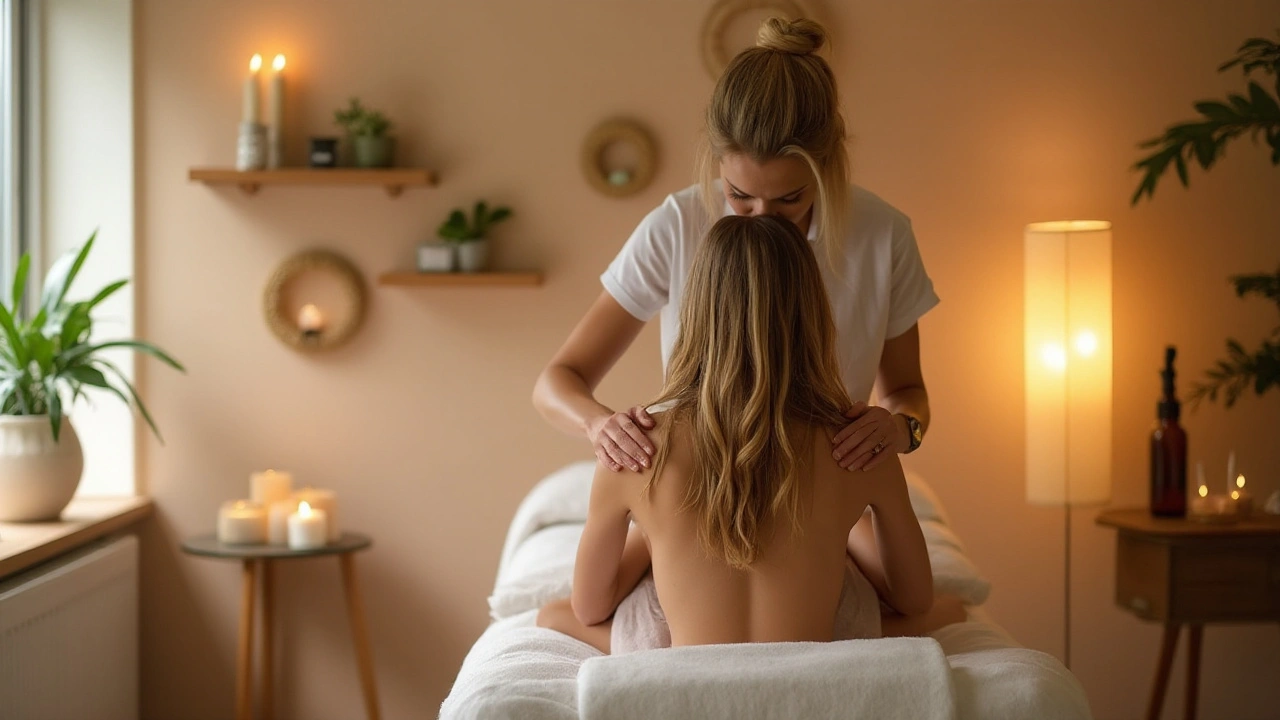Chair massage therapy is a unique modality that offers relaxation and therapeutic benefits in a convenient, portable format. Without the need for a massage table or special oils, it can be easily administered in various settings, making it perfect for busy individuals seeking quick relief. Whether it's at your workplace or a public event, chair massage caters to a fast-paced lifestyle by offering stress relief and promoting overall wellness.
Unlike traditional massage sessions, chair massages are typically shorter and more affordable, focusing on key tension areas such as the back, shoulders, and neck. This makes them a popular choice for those wanting immediate benefits without a large time commitment.
With the array of potential health benefits, including reduced anxiety and improved circulation, chair massage is an increasingly popular choice for those looking to boost their well-being in a practical, efficient way. As we delve into the benefits and tips for maximizing your chair massage experience, you'll find how this form of therapy can seamlessly fit into your routine, enhancing your physical and mental health.
- Overview of Chair Massage
- Physical Health Benefits
- Mental Health Benefits
- Comparison with Other Therapies
- Practical Tips for a Chair Massage
- Choosing the Right Practitioner
Overview of Chair Massage
Chair massage therapy is a fascinating aspect of alternative health that combines convenience and effectiveness, making it accessible to even the busiest individuals. Developed in the early 1980s by David Palmer, chair massage was innovatively designed to meet the demands of fast-paced environments, such as workplaces and public spaces. This method reached popularity quickly due to its adaptability, requiring minimal setup and space, as opposed to the traditional massages. Importantly, it is typically performed over clothing, eliminating the need for special oils or undressing, which makes it more comfortable for those new to massage therapy.
The technique focuses primarily on the upper body, especially areas where tension frequently accumulates, like the neck, shoulders, back, and arms. These sessions are usually brief, often lasting from 10 to 30 minutes, which allows them to be easily integrated into busy schedules without sacrificing too much time. Despite their brevity, the benefits of chair massage can be profound, providing significant relief from common discomforts caused by stress and sedentary habits, such as sitting at a desk all day.
Chair massage stands out not just for its innovation but also for its tangible health benefits. According to a study published in the Journal of Alternative and Complementary Medicine, just a 15-minute chair massage led to a significant reduction in anxiety and created noticeable improvements in alertness. This positions it as an ideal choice for professionals who need quick stress relief without the downtime of a full massage session. By relaxing the body's muscular structures, chair massages can improve circulation and flexibility, helping to prevent repetitive strain injuries often seen in office environments.
In addition to its practical benefits, chair massage therapy also promotes a sense of well-being and can enhance mental clarity. Many practitioners highlight the psychosomatic effects of massage, noting that the physical touch involved offers a subtle recalibration of stress response systems.
"It's remarkable how something so brief and seemingly simple can have such a deep impact on your mental and physical state," says Dr. John Smith, a leading expert in massage therapy.Indeed, individuals often report feeling rejuvenated and more focused post-session, ready to tackle the tasks that lie ahead. The ease with which this therapy can be offered in virtually any setting has contributed to its growing presence in corporate wellness programs and at public events.
For those skeptical about the benefits of such a seemingly simple therapy, consider its widespread application and acceptance among reputable health organizations. Chair massage isn't merely a trend; it's a recognized modality that serves as a gateway to improved health, making it a valuable addition to any wellness routine. Whether looking to unwind or boost productivity, this convenient therapy offers a multitude of advantages waiting to be discovered by the modern wellness seeker.
Physical Health Benefits
When it comes to enhancing physical health, chair massage therapy offers a surprising array of benefits that are both immediate and cumulative. One of the most notable effects is the improvement in blood circulation. By targeting key muscle groups in the upper body, chair massage stimulates blood flow, which is vital for transporting oxygen and nutrients to tissues. This increased circulation not only revitalizes tired muscles but also contributes to healthier skin and faster recovery from physical exertion.
Another significant benefit is the reduction of muscle tension, particularly in the neck, shoulders, and back areas, which are often prone to stress-induced tightness. Regular sessions help alleviate discomfort caused by prolonged sitting or improper posture, common in today's sedentary work environments. This is effective in preventing the stiffness that can lead to chronic pain conditions like tension headaches or the dreaded desk-worker's backache. By addressing these issues early on, chair massage aids in maintaining better postural habits.
Interestingly, chair massage has been noted for its ability to boost the immune system. Studies have shown that massage can increase lymphatic circulation, which is crucial for the removal of toxins and increasing immune function. This makes regular massage sessions a strategic part of a health regimen, especially during colder months when the body is more susceptible to illnesses. In fact, research published in the International Journal of Neuroscience discovered a significant increase in the production of immune-boosting cells among individuals who received regular massages.
A study in the Journal of Alternative and Complementary Medicine highlights that approximately 60% of people who received regular chair massages reported a reduction in neck and shoulder pain. This effectively demonstrates how accessible and impactful this form of therapy can be.
Moreover, chair massage plays a crucial role in pain management. Many individuals use it to manage chronic conditions or post-injury pain, often reporting decreased reliance on pain medications. The relief from physical aches and stiffness allows individuals to embrace more activity and exercise, fostering a healthier lifestyle overall. Massage therapy, due to its non-invasive nature, offers a complementary solution without the side effects associated with pharmaceutical alternatives.
Lastly, the compact and affordable nature of chair massage equipment makes it feasible for use in various settings, allowing individuals to reap health benefits without significant financial investment. It's not just a luxury but a practical addition to any comprehensive wellness plan. Offering both quick relief and long-term health benefits, chair massage is an efficient therapy that continues to gain recognition across health-conscious communities.

Mental Health Benefits
It's fascinating how a simple chair massage can profoundly impact one's mental health. The fast-paced world we live in often leaves individuals feeling overwhelmed, stressed, and mentally exhausted. A chair massage helps alleviate these common issues by promoting relaxation and improving mental clarity. When you settle into a chair massage, your body releases endorphins, those delightful brain chemicals that act as natural painkillers and mood elevators. This physiological response can help reduce feelings of anxiety and improve your overall mood.
A noteworthy aspect of chair massages is their accessibility. You can access them at work during breaks, in specialized clinics, or even at events like trade shows and conferences. This ease of access means you can begin to feel the calming effects in just a few short minutes. This quick change in mental status is vital, especially for people who might not have the luxury of time for longer relaxation routines but still want a meaningful mental break from the daily grind. It's like hitting a reset button for your mind, allowing you to approach tasks with renewed focus and reduced stress levels.
Regular chair massage sessions don't just offer temporary relief. Over time, consistently allowing yourself moments of peace and relaxation can lead to lasting changes in how you handle stress and anxiety. Chronic stress can cloud judgment and emotionally wear people down. A study published in the International Journal of Neuroscience found that massage therapy helps reduce stress even on a neurological level by decreasing cortisol levels while increasing serotonin and dopamine.
According to Dr. Tiffany Field, a leading researcher in massage therapy, "The touch involved in chair massages can regulate the nervous system, easing symptoms of anxiety and depression."
Engaging in chair massage regularly is a proactive approach to maintaining mental health. It’s important to see these sessions not only as a means to address immediate anxiety but also as a preventive strategy that enhances long-term mental well-being. By integrating chair massage into your routine, you reduce the frequency and intensity of mental health flare-ups, finding that your capacity to handle daily stressors becomes far more robust. It's a simple, yet effective tool in the mental health toolkit, offering benefits that can be both immediate and enduring.
Comparison with Other Therapies
When comparing chair massage with other therapeutic methods, it's essential to understand the distinctive benefits and limitations of each. Traditional table massages, for instance, typically offer comprehensive body relaxation sessions lasting about an hour or more. Such extended durations allow for deeper muscle work and a broader focus area, which might be necessary for those dealing with chronic pain or tension. However, this approach requires both more time and financial investment, factors not always feasible for everyone.
On the other hand, chair massage is centered on efficiency and accessibility. Sessions are shorter, usually ranging from 10 to 30 minutes, which makes it an ideal choice for a midday stress relief boost. Its structure allows clients to remain fully clothed, removing any discomfort some might feel with traditional massage settings. Corporate environments and public events frequently incorporate chair massages due to these logistical benefits, offering quick yet effective stress relief for employees or attendees. An additional plus is the reduced cost compared to other forms of massage therapy, making it attractive for those on a budget.
Let's juxtapose it with physical therapy. Unlike physical therapy, which is often tailored toward rehabilitating specific injuries or managing illnesses through prescribed exercises and manual manipulation, chair massage primarily targets stress and tension management. While both methodologies focus on improving bodily function and well-being, their applications can vary widely based on the individual's health objectives. Therefore, while physical therapy might be recommended for a sprain rehabilitation, chair massage is better suited for preventative care and stress reduction. In the words of Dr. Rachel Davis, a renowned physical therapist,
"Chair massage bridges the gap between therapeutic relaxation and practical accessibility, a perfect blend for the fast-paced lifestyles we lead today."
Acupuncture presents another interesting point of comparison. This ancient practice involves inserting fine needles into specific body points with the intention of rebalancing the body's energy. While both acupuncture and chair massage aim to alleviate pain and reduce stress, many prefer massage for its more immediate gratifying nature and its non-invasive technique. Additionally, chair massages do not require the preparatory understanding needed for acupuncture, like discussing specific meridian points or individual health assessments for treatment planning.
For a broader perspective, let's consider the time efficiency and outcomes of these therapies:
| Therapy Type | Average Session Length | Typical Cost per Session | Focus |
|---|---|---|---|
| Chair Massage | 10-30 minutes | Low | Stress Relief, Tension |
| Traditional Table Massage | 60-90 minutes | Medium to High | Full Body Relaxation |
| Physical Therapy | 30-60 minutes | Varies (Insurance) | Rehabilitation, Pain Management |
| Acupuncture | 20-60 minutes | Medium | Energy Balance, Pain Relief |
In conclusion, chair massage holds its unique place in the wellness world by offering a blend of effectiveness, convenience, and affordability. Its design caters to people with varied schedules and stress levels, making it a compelling choice among the vast landscape of therapeutic options available today.

Practical Tips for a Chair Massage
Starting your journey into the world of chair massage is straightforward, but a few practical tips can enhance the experience and benefits significantly. It's important to wear comfortable clothing that allows you to sit without restrictions, as the therapist will need easy access to your back, shoulders, and neck. Although you're not required to disrobe, loose-fitting garments make the process smoother and more enjoyable. You might also want to avoid heavy meals or caffeine right before your session, as it could lead to discomfort when applying pressure to specific areas.
The ambiance should not be underestimated — it’s an integral component of a successful therapy session. Try to find a quiet, relaxing space, even if you're at a bustling event or office. The right surroundings can minimize distractions and allow you to immerse fully in the moment. Adjust lighting to softer hues and consider using calming music, which can amplify the relaxing effects of the massage. Additionally, verbally expressing any areas of concern or discomfort to your therapist before starting can help them tailor the session to your needs, ensuring you get the most out of your time.
Hydration plays a pivotal role in maximizing the health benefits of massage. Drinking water before and after your session aids in detoxifying your body, helping to flush out the metabolic waste produced by muscle manipulation. A well-hydrated system acts more efficiently, enhancing circulation and reducing post-massage soreness. For those new to this practice, starting with a short 10 to 15 minute session might be ideal, as it gives your body a chance to adapt. As your comfort and need align, you might gradually extend the length of time.
Regularity is key to reaping long-term benefits. Consider integrating chair sessions into your routine. Whether it's weekly or bi-weekly, consistency in stress relief methods can lead to more pronounced results, such as reduced tension headaches and improved mental clarity. According to a study conducted by the American Institute of Stress, incorporating short bursts of relaxation can significantly decrease workplace stress, resulting in increased productivity and satisfaction:
"People who receive regular massages reported feeling more attentive and energized, contributing to a more harmonious work-life balance."
Finally, selecting the right therapist is crucial. Trust your instincts when interacting with various practitioners. A good therapist will listen actively and offer adjustments based on your feedback. Word-of-mouth recommendations or online reviews can offer insights into a therapist’s skills and approach. Keep in mind that every individual’s needs are different; what works well for one person may not be suitable for another.
Choosing the Right Practitioner
Finding the right practitioner for your chair massage is like choosing a trusted partner in your wellness journey. It involves considering various factors to ensure you receive not only a relaxing experience but one that's therapeutic and suited to your specific needs. When searching for a practitioner, start by checking their credentials. A certified massage therapist will have undergone training at a recognized institution and should hold relevant certifications or licensure for practicing in their region. This assures you that they understand the human body and the techniques required to provide a safe and effective massage.
Ask about the practitioner's experience specifically in chair massage. This modality requires a particular set of skills, as it involves working on a client who is seated and usually clothed. The practitioner should be adept at accessing and providing relief to common tension areas, such as the shoulders, neck, and back. An experienced therapist has likely encountered various scenarios and knows how to adjust their technique for different body types and needs. Seeking referrals or testimonials from previous clients can offer insight into the practitioner's reputation and the quality of their service.
Some practitioners may specialize in certain techniques, such as deep tissue or trigger point therapy, which can be crucial depending on your health goals. If you’re seeking relief from stress, you might prioritize someone skilled at employing gentle, soothing strokes. Those dealing with muscle tension might prefer someone focused on targeted pressure. Communication is key; you should feel comfortable discussing your health concerns and preferences with your practitioner. A reputable therapist will take the time to understand your objectives and any limitations you may have, customizing the session to maximize benefits.
Comfort and professionalism are other important factors. Interact with your prospective therapist, either in person or virtually, before scheduling your session. This meeting will give you a sense of their professionalism, communication style, and how well they listen to your needs. The location where the chair massage is conducted should be clean, peaceful, and conducive to relaxation. When assessing options, consider your comfort level with either visiting a facility or having a practitioner who offers mobile services visit your home or workplace.
In addition to these factors, cost can be a deciding element. While it's essential to find a practitioner who fits your budget, ensure you're also getting quality service. Typically, prices can vary based on experience, location, and the session's duration. Keep in mind that regular chair massages can contribute significantly to your health, so view it as an investment rather than an expenditure. Some workplaces offer in-office chair massages, which might be more economical, so check if this option is available to you.
If you're unsure where to start, there's a myriad of online resources and directories that can connect you with qualified therapists in your area. I'm reminded of advice from the American Massage Therapy Association, which states,
"The right therapist can make a world of difference in achieving your health and wellness goals—choose wisely and communicate openly."Making an informed choice about your practitioner not only enhances your immediate therapy experience but also contributes positively to your long-term well-being.

